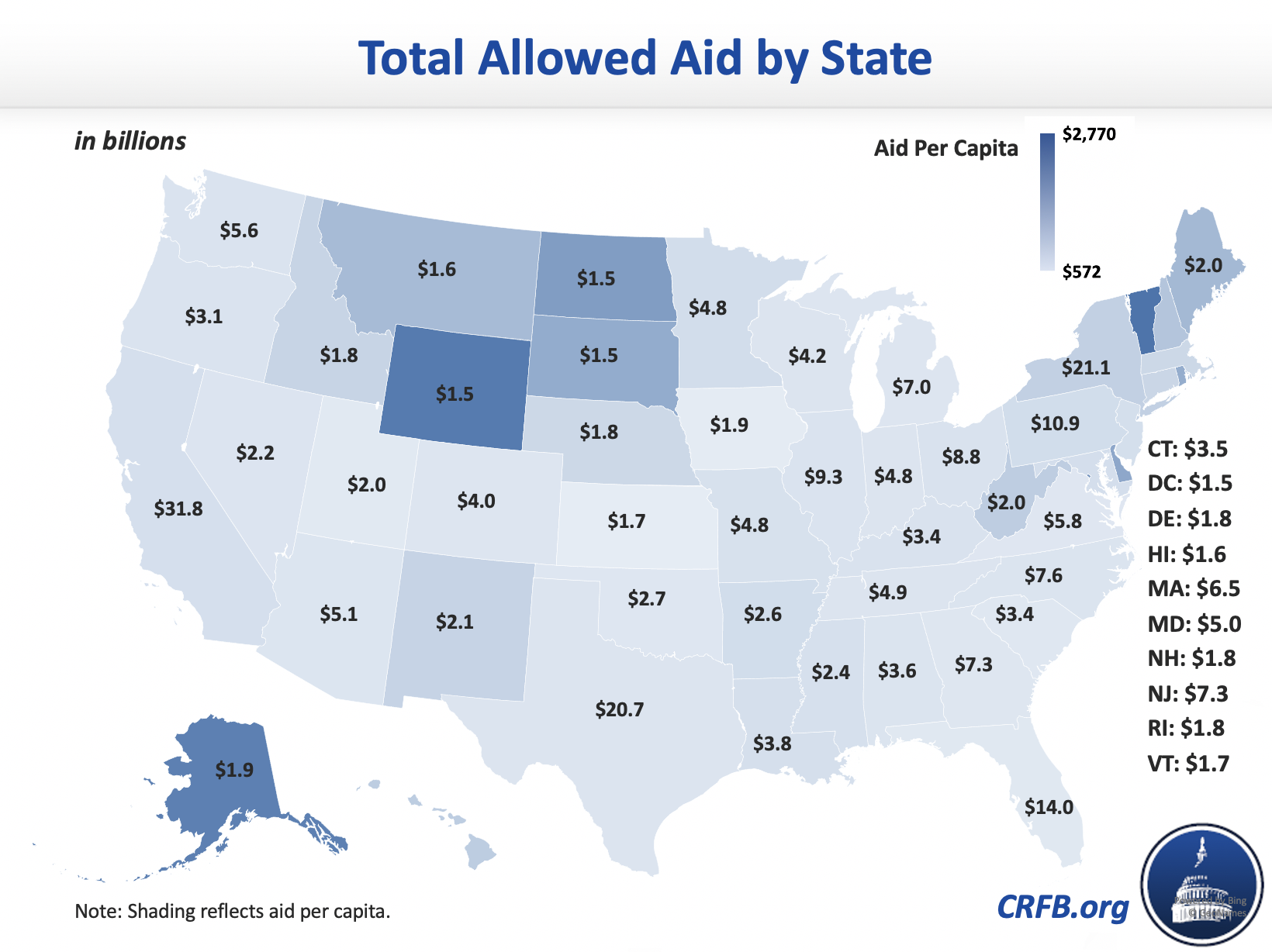Update: COVID-Related State & Local Aid Will Total $280 Billion
Our update to COVID Money Tracker this week incorporated new Medicaid estimates from the Congressional Budget Office (CBO). These new Medicaid projections led us to recategorize some spending, and while we continue to estimate that lawmakers allowed nearly $500 billion of COVID relief to be disbursed to state and local governments, we now classify around $280 billion of these funds as state and local aid — down from $360 billion in our prior estimates. Roughly three quarters of that relief, over $210 billion, has been committed or disbursed to date.

More than half of the aid to states and localities allowed so far was authorized through the $150 billion Coronavirus Relief Fund, which provides aid to state and local governments for COVID-related expenses. Nearly all of this aid has been disbursed.
We now estimate that another $85 billion of aid will come from the 6.2 percent increase in the Federal Medical Assistance Percentage (FMAP) authorized under the Families First Act (FFCRA), assuming the public health emergency continues through 2022. We estimate about $22 billion of this has been disbursed.
Last month, CBO estimated that total federal Medicaid spending would increase by more than $170 billion through 2023 under COVID relief legislation, mainly as a result of the 6.2 percent FMAP boost. However, more recent CBO data suggests that only half of this spending (including $30 billion in fiscal year 2021) will come directly from the higher FMAP match, while the remaining federal cost is largely the result of conditions associated with the higher match that states provide "continuous coverage" and maintain Medicaid generosity throughout the pandemic. This federal funding does go to states, but it covers new health care costs rather than backfilling state budgets — we therefore classify it as health care spending rather than state and local aid.
The higher match itself, on the other hand, essentially helps states close their existing budget shortfalls. By our rough estimates, California will ultimately receive $11 billion from this higher match, while New York will receive $8 billion, Texas will receive $7 billion, and Florida and Pennsylvania will receive $4 billion respectively. Other states will receive different amounts based on their size and Medicaid population.

On top of the Coronavirus Relief Fund and Medicaid boost, additional state and local aid has been promised in the form of $25 billion in transit grants, $17 billion in aid to public schools, and $400 million in election security grants. Nearly all these funds have been committed or disbursed.
Importantly, this federal assistance is not an exhaustive list of all the COVID-related dollars allocated or distributed to state and local governments. Around $100 billion of aid allocated to state and local governments was for disaster costs, community development, housing, health preparedness, reimbursement of certain prior-law unemployment benefit costs, and other spending, where (in most cases) the states essentially administer federal initiatives. Another $35 billion was allocated to support up to $500 billion in state and local bond purchases by the Federal Reserve — though so far the Municipal Lending Facility has only purchased $1.7 billion in bonds issued by the State of Illinois and New York's Metropolitan Transit Authority (MTA).
This analysis also does not include any indirect support to states. For example, the roughly $500 billion in expanded unemployment benefits are likely to generate tens of billions of dollars in state & local income and sales tax revenue, in part because unemployment is taxable as income in the majority of states. In general, policies that boost economic output or increase disposable income will improve the finances of state and local governments.
The funding we do classify as direct state and local aid has and will continue to go to all 50 states, the District of Columbia, tribal areas, and various U.S. territories. We estimate California will get the most aid — $32 billion — while Vermont will get the most aid per capita ($2,770).

Despite this support, states and localities could still face substantial budget shortfalls and balanced budget requirements may force states to make decisions that could hamper the economic recovery. As they consider further COVID relief, policymakers should work together to identify a reasonable package to help address the needs of states and localities, the broader economy, and those suffering as a result of the current pandemic and economic crisis.

